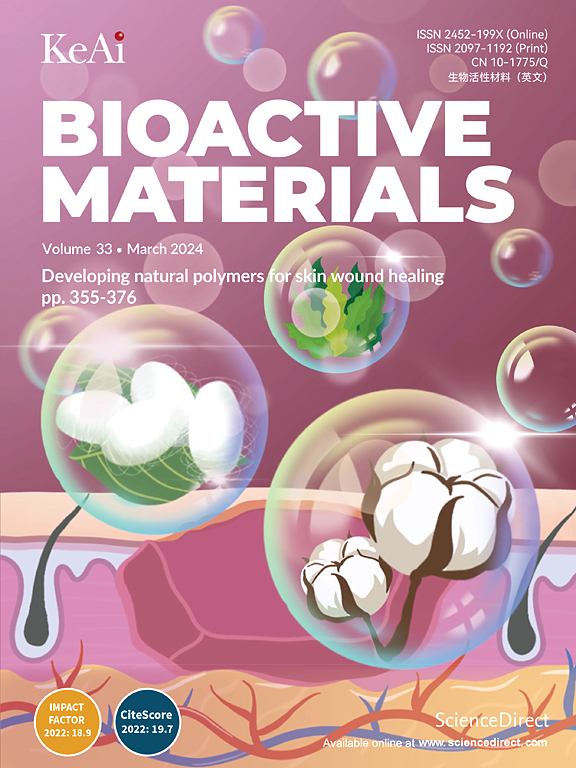Bidirectional modulation of glycolysis using a multifunctional nanocomposite hydrogel promotes bone fracture healing in type 2 diabetes mellitus
IF 18
1区 医学
Q1 ENGINEERING, BIOMEDICAL
引用次数: 0
Abstract
Fracture healing in patients with type 2 diabetes mellitus (T2D) is markedly impaired, characterized by a prolonged inflammation phase and defective osteoblast differentiation at the fracture site. In this study, we identified aberrant cellular glycolysis at T2D fracture sites, with bone marrow mesenchymal stem cells (BMSCs) exhibiting suppressed glycolysis and macrophages displaying enhanced glycolysis, mediated by the dysregulation of hypoxia-inducible factor-1α (HIF-1α). To rectify these metabolic imbalances, we developed a multifunctional nanocomposite PN@MHV hydrogel. Myricitrin, a flavonoid glycoside, forms the MHV hydrogel by cross-linking with HA-PBA and PVA via hydrogen bonds, and upregulates glycolysis through HIF-1α, thus promoting osteoblast differentiation under high glucose environment. To further regulate the inflammatory microenvironment, we incorporated nanoparticles loaded with PX-478, a HIF-1α specific inhibitor, into the hydrogel, with folic acid covalently modified to target proinflammatory M1 macrophages. This PN@MHV hydrogel bidirectionally regulated glycolysis via HIF-1α, enhancing osteoblast differentiation while attenuating macrophage-mediated inflammation. Comprehensive in vitro and in vivo experiments in a T2D fracture mouse model confirmed the hydrogel's ability to improve the inflammatory microenvironment and accelerate bone healing. Our findings underscore the therapeutic potential of targeting cellular glycolysis as a promising approach for enhancing fracture healing in diabetic patients.

使用多功能纳米复合水凝胶双向调节糖酵解促进2型糖尿病骨折愈合
2型糖尿病(T2D)患者的骨折愈合明显受损,其特征是炎症期延长和骨折部位成骨细胞分化缺陷。在这项研究中,我们在T2D骨折部位发现了异常的细胞糖酵解,骨髓间充质干细胞(BMSCs)表现出糖酵解抑制,而巨噬细胞表现出糖酵解增强,这是由缺氧诱导因子-1α (HIF-1α)的失调介导的。为了纠正这些代谢失衡,我们开发了一种多功能纳米复合材料PN@MHV水凝胶。Myricitrin是一种类黄酮苷,通过氢键与HA-PBA和PVA交联形成MHV水凝胶,并通过HIF-1α上调糖酵解,促进高糖环境下成骨细胞的分化。为了进一步调节炎症微环境,我们将装载HIF-1α特异性抑制剂PX-478的纳米颗粒加入到水凝胶中,并将叶酸共价修饰以靶向促炎M1巨噬细胞。这种PN@MHV水凝胶通过HIF-1α双向调节糖酵解,增强成骨细胞分化,同时减弱巨噬细胞介导的炎症。在T2D骨折小鼠模型中进行的全面体外和体内实验证实了水凝胶改善炎症微环境和加速骨愈合的能力。我们的研究结果强调了靶向细胞糖酵解作为一种有希望的方法来促进糖尿病患者骨折愈合的治疗潜力。
本文章由计算机程序翻译,如有差异,请以英文原文为准。
求助全文
约1分钟内获得全文
求助全文
来源期刊

Bioactive Materials
Biochemistry, Genetics and Molecular Biology-Biotechnology
CiteScore
28.00
自引率
6.30%
发文量
436
审稿时长
20 days
期刊介绍:
Bioactive Materials is a peer-reviewed research publication that focuses on advancements in bioactive materials. The journal accepts research papers, reviews, and rapid communications in the field of next-generation biomaterials that interact with cells, tissues, and organs in various living organisms.
The primary goal of Bioactive Materials is to promote the science and engineering of biomaterials that exhibit adaptiveness to the biological environment. These materials are specifically designed to stimulate or direct appropriate cell and tissue responses or regulate interactions with microorganisms.
The journal covers a wide range of bioactive materials, including those that are engineered or designed in terms of their physical form (e.g. particulate, fiber), topology (e.g. porosity, surface roughness), or dimensions (ranging from macro to nano-scales). Contributions are sought from the following categories of bioactive materials:
Bioactive metals and alloys
Bioactive inorganics: ceramics, glasses, and carbon-based materials
Bioactive polymers and gels
Bioactive materials derived from natural sources
Bioactive composites
These materials find applications in human and veterinary medicine, such as implants, tissue engineering scaffolds, cell/drug/gene carriers, as well as imaging and sensing devices.
 求助内容:
求助内容: 应助结果提醒方式:
应助结果提醒方式:


